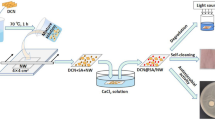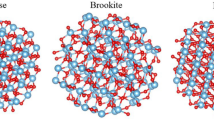Abstract
Numerous catalysts for water pollutant mitigation have been developed over recent decades. However, the utilization of catalysts embedded in 3D structures remains challenging. This study aims at fabricating 3D-printed TiO2/SiO2/polymer scaffolds for the degradation of organic dyes, specifically Methylene Blue (MB) and rhodamine B (Rh B). The TiO2/SiO2/polymer scaffolds were fabricated by stereolithography (SLA) technique, using TiO2 photocatalyst synthesized via a solution combustion process, silica adsorbent prepared from sugarcane leaves, and photocurable resin as feedstock. X-ray diffraction analysis confirmed that TiO2 exhibited anatase/rutile/brookite triphasic structure while SiO2 possessed amorphous structure. Scanning electron micrographs revealed that TiO2 and SiO2 particles uniformly deposited on the surface of the photocurable resin. The adsorption activity of the TiO2/SiO2/polymer scaffolds was examined in the dark for 24 h to ensure that adsorption equilibrium was achieved. Photocatalytic examinations were conducted under UV light (λ = 365 nm). The TiO2/SiO2/polymer scaffolds efficiently demonstrated their potential dye removal efficiency against MB and Rh B dyes as 81.9% and 60%, respectively. Reusability testing revealed that after hydrogen peroxide treatment, the used scaffolds exhibited the degradation ability in a comparable range to the as-fabricated scaffolds. An application of a 3D printing technique for water pollution reduction was successfully demonstrated in this study.










Similar content being viewed by others
Data availability
The data will be made available upon request.
References
Lam S-M, Sin J-C, Abdullah AZ, Mohamed AR (2012) Desalin Water Treat 41:131–169
Srivatsav P, Bhargav BS, Shanmugasundaram V, Arun J, Gopinath KP, Bhatnagar A (2020) Water 12:3561
Kadirvelu K, Kavipriya M, Karthika C, Radhika M, Vennilamani N, Pattabhi S (2003) Bioresour Technol 87:129–132
Allouche FN, Yassaa N (2018) IOP Conf Ser Mater Sci Eng 323:012006
Han TH, Khan MM, Kalathil S, Lee J, Cho MH (2013) Ind Eng Chem Res 52:8174–8181
Kayabaşı Y, Erbaş O (2020) Demiroglu Sci Univ Florence Nightingale J Med 6:136–145
Khan I, Saeed K, Zekker I, Zhang B, Hendi AH, Ahmad A, Ahmad S, Zada N, Ahmad H, Shah LA (2022) Water 14:242. https://doi.org/10.3390/w14020242
Weng C-H, Pan Y-F (2007) J Hazard Mater 144:355–362
Srivastava V, Sillanpää M (2017) J Environ Sci 51:97–110
Ahn D-H, Chang W-S, Yoon T-I (1999) Process Biochem 34:429–439
Bergamonti L, Gentili S, Acquotti D, Tegoni M, Lottici PP, Graiff C (2021) J Hazard Mater 410:124585
Kandisa R, Narayana SKV, Khasim BS, Gopinath R (2016) J Bioremediation Biodegrad 7:6
Singh A, Pal DB, Mohammad A, Alhazmi A, Haque S, Yoon T, Srivastava N, Gupta VK (2022) Bioresour Technol 343:126154
Visvanathan C, Aim RB, Parameshwaran K (2000) Crit Rev Environ Sci Technol 30:1–48
Wong S, Ghafar NA, Ngadi N, Razmi FA, Inuwa IM, Mat R, Amin NAS (2020) Sci Rep 10:2928
Kim S, Ohulchanskyy TY, Pudavar HE, Pandey RK, Prasad PN (2007) J Am Chem Soc 129:2669–2675
Darvishi Cheshmeh Soltani R, Khataee AR, Safari M, Joo SW (2013) I Int Biodeterior Biodegradation 85:383–391
Cansee S (2010) Am J Eng Appl Sci 3:186–188
Pipitpukdee S, Attavanich W, Bejranonda S (2020) Atmosphere (Basel) 11:408
Rostamian R, Najafi M, Rafati AA (2011) Chem Eng J 171:1004–1011
Rovani S, Santos JJ, Corio P, Fungaro DA (2018) ACS Omega 3:2618–2627
Silalertruksa T, Gheewala SH (2018) J Clean Prod 182:521–528
Le Blond JS, Horwell CJ, Williamson BJ, Oppenheimer C (2010) J Environ Monit 12:1459–1470
Oo HM, Karin P, Chollacoop N, Hanamura K (2021) J Environ Sci 99:296–310
Siddiqui B, Haq I-u, Al-Dossary AA, Elaissari A, Ahmed N (2022) Int J Pharm X 4:100116
Kong D, Cheng C, Wang Y, Wong JI, Yang Y, Yang HY (2015) J Mater Chem A 3:16150–16161
Raj SI, Jaiswal A, Uddin I (2019) RSC Adv 9:11212–11219
Chen J, Xiong Y, Duan M, Li X, Li J, Fang S, Qin S, Zhang R (2020) Langmuir 36:520–533
Elshabrawy O, Horwell C, Williamson B, Oppenheimer C (2010). J Environ Sci Technol. https://doi.org/10.1007/s13762-023-04831-x
Solís-Casados DA, Elhussieny AA, Taha MM, Pal K, Fahim IS (2023) Int J 63:564–574
Abdullah FH, Bakar NHHA, Bakar MA (2022) J Hazard Mater 424:127416
Bergamonti L, Graiff C, Bergonzi C, Potenza M, Reverberi C, Ossiprandi MC, Lottici PP, Bettini R, Elviri L (2022) Catal 12:580
Lee KM, Lai CW, Ngai KS, Juan JC (2016) Water Res 88:428–448
Lee S-Y, Park S-J (2013) J Ind Eng Chem 19:1761–1769
Sing KS (1985) Pure Appl Chem 57:603–619
Chen X, Jiang J, Yan F, Tian S, Li K (2014) RSC Adv 4:8703–8710
Younis SA, Amdeha E, El-Salamony RA (2021) J Environ Chem Eng 9:104619
Ferreira-Neto EP, Ullah S, Da Silva TC, Domeneguetti RR, Perissinotto AP, De Vicente FS, Rodrigues-Filho UP, Ribeiro SJ (2020) ACS Appl Mater Interf. 12:41627–41643
Szatkowski T, Siwińska-Stefańska K, Wysokowski M, Stelling AL, Joseph Y, Ehrlich H, Jesionowski T (2017) Biomimetics 2:4
Yamamoto H, Demura T, Morita M, Kono S, Sekine K, Shinada T, Nakamura S, Tanii T (2014) Biofabrication 6:035021
Kafle A, Luis E, Silwal R, Pan HM, Shrestha PL, Bastola AK (2021) Polymers (Basel) 13:3101
Huang J, Qin Q, Wang J (2020) Processes 8:1138
Ngo TD, Kashani A, Imbalzano G, Nguyen KTQ, Hui D (2018) Compos Part B Eng 143:172–196
Relinque JJ, Romero-Ocaña I, Navas-Martos FJ, Delgado FJ, Domínguez M, Molina SI (2020) Polymers Basel 12:1642
Gdula K, Dąbrowski A, Skwarek E (2016) Adsorption 22:681–688
Luttrell T, Halpegamage S, Tao J, Kramer A, Sutter E, Batzill M (2014) Sci Rep 4:4043
Zabar Z, Merabet S, Abdullah AH, Khezami L, Bououdina M (2022) Environ Nanotechnol Monit Manag 18:100734
Zhang J, Zhou P, Liu J, Yu J (2014) Phys Chem Chem Phys 16:20382–20386
Manzoli M, Freyria FS, Blangetti N, Bonelli B (2022) RSC Adv 12:3322–3334
Luo Z, Poyraz AS, Kuo C-H, Miao R, Meng Y, Chen S-Y, Jiang T, Wenos C, Suib SL (2015) Chem Mater 27:6–17
Preethi LK, Mathews T, Nand M, Jha SN, Gopinath CS, Dash S (2017) Appl Catal B Environ 218:9–19
Mizutaru T, Sakuraba T, Nakayama T, Marzun G, Wagener P, Rehbock C, Barcikowski S, Murakami K, Fujita J, Ishii N, Yamamoto Y (2015) J Mater Chem A 3:17612–17619
Grosman A, Ortega C (2008) Langmuir 24:3977–3986
El-Samak AA, Ponnamma D, Hassan MK, Al-Maadeed MAA (2022) Microporous Mesoporous Mater 341:111994
Yang Z-Y, Shen G-Y, He Y-P, Liu X-X, Yang S-J (2016) J Porous Mater 23:589–599
Joseph CG, Taufiq-Yap YH, Musta B, Sarjadi MS, Elilarasi L (2021). Front Chem. https://doi.org/10.3389/fchem.2020.568063
Kumbhakar P, Ambekar R, Mahapatra P, Tiwary C (2021) J Hazard Mater 418:126383
Rápó E, Tonk S (2021) Molecules 26:5419
Jinendra U, Bilehal D, Nagabhushana BM, Kumar AP (2021) Heliyon 7:06851
Acknowledgements
This work was financially supported by International Collaborative Education Program for Material Technology, Education, and Research (ICE-Matter), ASEAN University Network, Southeast Asia Engineering Education Development Network (AUN/SEED-Net), Japan International Cooperation Agency (JICA), and the Kasetsart University Research and Development Institute (KURDI, grant no. FF(KU) 25.64). This work was also financially supported by the Office of the Ministry of Higher Education, Science, Research and Innovation; and the Thailand Science Research and Innovation through the Kasetsart University Reinventing University Program
Funding
Asean University Network,Kasetsart University Research and Development Institute, FF(KU) 25.64, Gasidit Panomsuwan, Science and Technology Postgraduate Education and Research Development Office, Office of the Higher Education Commission, Kasetsart University Reinventing University Program,Oratai Jongprateep
Author information
Authors and Affiliations
Corresponding authors
Additional information
Publisher's Note
Springer Nature remains neutral with regard to jurisdictional claims in published maps and institutional affiliations.
Rights and permissions
Springer Nature or its licensor (e.g. a society or other partner) holds exclusive rights to this article under a publishing agreement with the author(s) or other rightsholder(s); author self-archiving of the accepted manuscript version of this article is solely governed by the terms of such publishing agreement and applicable law.
About this article
Cite this article
Bansiddhi, A., Panomsuwan, G., Hussakan, C. et al. Ecofriendly 3D Printed TiO2/SiO2/Polymer Scaffolds for Dye Removal. Top Catal 66, 1662–1673 (2023). https://doi.org/10.1007/s11244-023-01864-x
Accepted:
Published:
Issue Date:
DOI: https://doi.org/10.1007/s11244-023-01864-x




